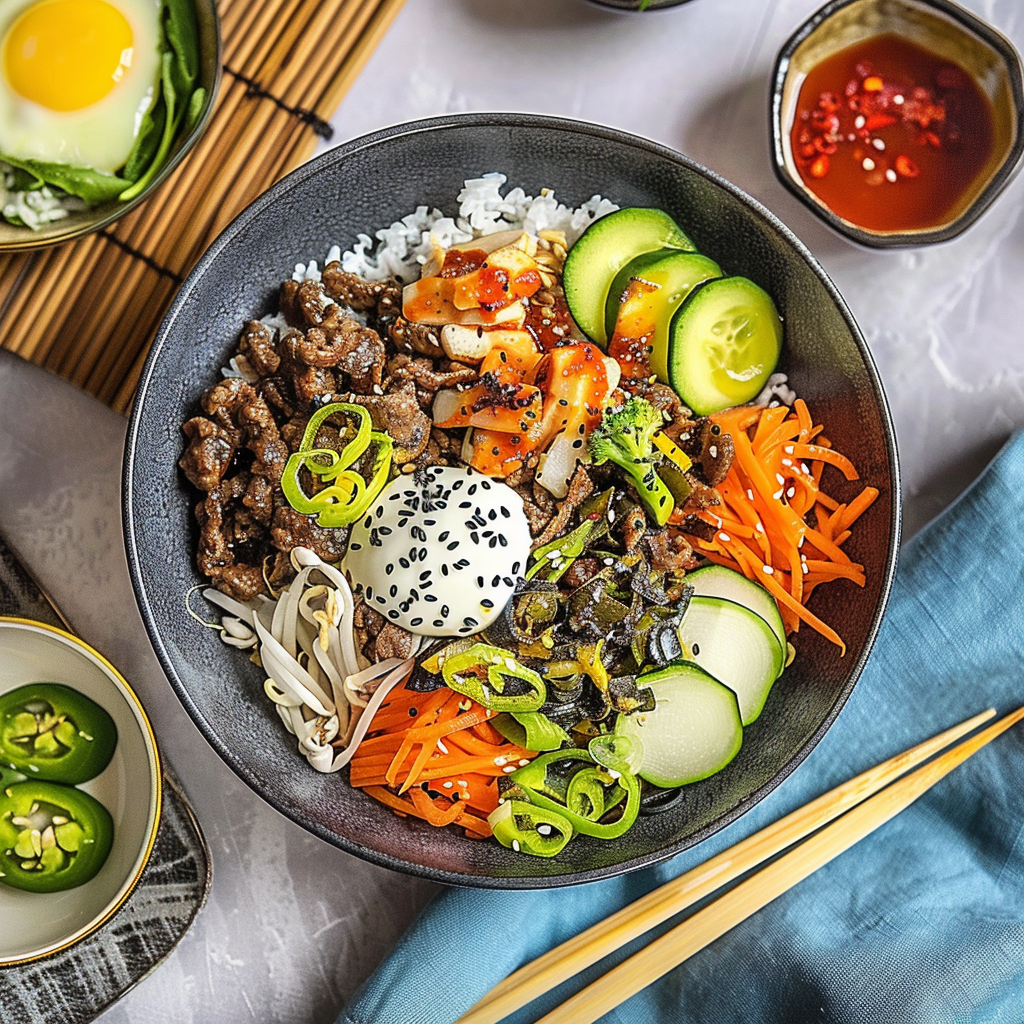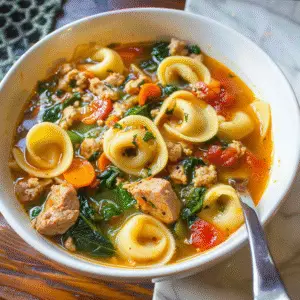Korean Beef Bibimbap Bowls are a delightful explosion of flavors and textures that will make your taste buds dance. Imagine the savory blend of marinated beef, vibrant vegetables, and a perfectly runny egg all mingling together in a bowl, creating a symphony of deliciousness that sings harmony with every bite.
Every time I whip up Korean Beef Bibimbap Bowls, I’m transported back to my favorite Korean restaurant where the aromas wafting through the air made my stomach growl louder than a bear in hibernation. This dish is perfect for family gatherings, cozy nights in, or when you want to impress your friends without spending hours in the kitchen. Get ready to dive into a flavor-packed experience that will leave you craving more.
Why You'll Love This Korean Beef Bibimbap Bowls
- This incredible Korean Beef Bibimbap Bowls transforms simple everyday ingredients into restaurant-quality flavors that will blow your mind completely.
- Foolproof recipe techniques guarantee perfect results every single time, making even novice cooks feel like professional chefs instantly.
- Stunning visual appeal with gorgeous colors and mouthwatering aromas creates the ultimate Instagram-worthy dish for any special occasion.
- Endlessly adaptable for different dietary needs while working beautifully for meal prep, date nights, or entertaining large groups effortlessly.
One memorable evening, I served this dish to my friends during an impromptu dinner party, and their reactions were priceless—let’s just say there was more slurping than polite conversation.
Essential Ingredients
Here’s what you’ll need to make this delicious dish:
-
Ground Beef: Choose lean ground beef for a tender texture without excessive grease; it makes a significant difference in flavor.
-
Cooked Rice: Ideally use short-grain rice for its chewy texture that holds up well against the toppings.
-
Spinach: Fresh spinach works best; it wilts beautifully when sautéed and adds a vibrant green color.
-
Carrots: Julienne them thinly for quick cooking and maximum sweetness; they add a lovely crunch.
-
Zucchini: Sliced thinly or spiralized, zucchini adds freshness and balances out the hearty beef.
-
Soy Sauce: Opt for low-sodium soy sauce to keep salt levels in check while enhancing the flavor profile.
-
Sesame Oil: A drizzle of sesame oil at the end elevates the dish with its nutty aroma and richness.
-
Eggs: Use fresh eggs to create that glorious runny yolk that ties all the flavors together beautifully.
-
Gochujang (Korean Chili Paste): For those who love heat, this ingredient adds depth and spice; adjust according to your tolerance!
The full ingredients list, including measurements, is provided in the recipe card directly below.

How to Make Korean Beef Bibimbap Bowls
Let’s get cooking! Follow these steps to create your own Korean Beef Bibimbap Bowls.
Prepare Your Ingredients: Start by washing and prepping all your veggies: julienne carrots and zucchini while also rinsing spinach under cool water until clean.
Cook the Ground Beef: In a skillet over medium heat, cook ground beef until browned thoroughly. Drain excess fat if necessary; you want flavorful meat without it swimming in grease.
Sauté Vegetables: In another pan, heat oil over medium-high heat. Add carrots first; sauté for about 2 minutes until slightly tender before adding zucchini and spinach. Stir-fry until vibrant yet crisp.
Add Flavorings: Return cooked ground beef to vegetables in the skillet. Pour in soy sauce and sesame oil; stir everything together until combined evenly with aromatic bliss filling your kitchen.
Fry Eggs: In a separate pan, fry eggs sunny-side up over medium-low heat until whites are set but yolks remain runny—this will create delicious creaminess when mixed into your bibimbap bowl.
Assemble Your Bowl: Place hot cooked rice at the bottom of each bowl. Layer on sautéed veggies followed by ground beef mixture. Top with fried egg and finish with gochujang drizzle if desired!
Now you’re ready to dig into those stunning Korean Beef Bibimbap Bowls! Each spoonful is more exciting than finding money in an old jacket pocket—pure joy!
This showstopping Korean Beef Bibimbap Bowls delivers restaurant-quality results using simple ingredients you probably already have at home. The perfect balance of textures and flavors creates an unforgettable dining experience that will have everyone asking for seconds. Picture-perfect presentation with vibrant colors makes this dish absolutely Instagram-worthy and guaranteed to impress any dinner guest. Incredibly versatile recipe that works beautifully for weeknight dinners, meal prep, special occasions, or even outdoor entertaining sessions.
Perfecting the Cooking Process
To achieve seamless timing and textures in your Korean Beef Bibimbap Bowls, start by marinating the beef while prepping the veggies. Sear the beef first for a rich flavor, then stir-fry your vegetables until they are crisp-tender. Finally, cook the rice so that everything is ready at once. This method ensures each component shines in flavor and texture without any overcooking.
Add Your Touch
Feel free to customize your Korean Beef Bibimbap Bowls to suit your taste buds! Swap out beef for chicken or tofu if you prefer a lighter option. Experiment with different vegetables like zucchini or bell peppers for added crunch. Don’t forget optional toppings like sesame seeds and gochujang for that authentic spicy kick! Personalize it to make every bowl uniquely yours.
Storing & Reheating
To keep your Korean Beef Bibimbap Bowls fresh, store each component separately in airtight containers in the refrigerator for up to three days. When reheating, warm the beef and veggies in a skillet over medium heat until heated through, about 5-7 minutes. For rice, sprinkle with a splash of water and microwave briefly to restore moisture before serving.
Chef's Helpful Tips for Korean Beef Bibimbap Bowls
- This professional-quality Korean Beef Bibimbap Bowls relies on precise timing and temperature control to achieve restaurant-standard results consistently.
- Master the art of mise en place by prepping all ingredients beforehand, ensuring smooth execution and preventing any last-minute cooking disasters.
- The secret lies in layering flavors throughout the cooking process rather than seasoning only at the end for maximum depth.
- Let the finished dish rest for optimal texture and flavor development before serving to hungry guests waiting eagerly.
My first attempt at making Korean Beef Bibimbap was a chaotic kitchen adventure involving a runaway vegetable peeler and a dog who thought he was my sous chef! Despite the mess, everyone loved it—especially my best friend who declared it “the best thing since sliced bread.”
FAQ
What is bibimbap?
Bibimbap is a traditional Korean dish that translates to “mixed rice.” It typically features rice topped with assorted vegetables, meat (often beef), a fried egg, and seasoned with gochujang (Korean chili paste). It’s known for its colorful presentation and balanced flavors.
Can I make bibimbap vegetarian?
Absolutely! You can easily make Korean Beef Bibimbap vegetarian by substituting meat with tofu or tempeh. Use plenty of veggies like spinach, carrots, mushrooms, and zucchini to add texture and flavor while keeping it deliciously satisfying.
How do I serve bibimbap?
Serve Korean Beef Bibimbap warm in individual bowls with rice as the base layer. Arrange your cooked beef and vegetables artistically on top of the rice. Don’t forget to top it off with a fried egg for that creamy richness—mix everything together just before eating!
What can I use instead of gochujang?
If you can’t find gochujang, try mixing miso paste with a bit of chili powder as an alternative. While it won’t be exactly the same flavor-wise, it still adds that umami goodness you crave without straying too far from tradition.
Conclusion for Korean Beef Bibimbap Bowls
In summary, mastering Korean Beef Bibimbap Bowls involves understanding cooking sequences and personalizing ingredients to suit your tastes. With customizable options abound—whether it’s swapping proteins or adding vibrant veggies—this dish guarantees satisfaction every time it graces your table. Remember to follow storage tips for leftovers so every bite remains just as delicious as when freshly made! Enjoy creating this culinary masterpiece that’s sure to impress friends and family alike!
Korean Beef Bibimbap Bowls
Korean Beef Bibimbap Bowls are a vibrant and flavorful dish that brings together marinated ground beef, fresh vegetables, and a runny fried egg atop a bed of rice. This one-bowl meal is not only visually stunning but also easy to prepare, making it perfect for any occasion, from weeknight dinners to gatherings with friends. Each bite offers a delightful mix of textures and tastes that will transport you to your favorite Korean restaurant.
- Prep Time: 15 minutes
- Cook Time: 20 minutes
- Total Time: 35 minutes
- Yield: Serves 4
- Category: Main
- Method: Sautéing
- Cuisine: Korean
Ingredients
- 1 lb lean ground beef
- 2 cups cooked short-grain rice
- 1 cup fresh spinach
- 1 cup carrots, julienned
- 1 cup zucchini, thinly sliced
- 2 tbsp low-sodium soy sauce
- 1 tbsp sesame oil
- 4 large eggs
- 2 tbsp gochujang (Korean chili paste)
Instructions
- Prepare the ingredients: Wash and julienne the carrots and zucchini; rinse the spinach.
- Cook the beef: In a skillet, brown the ground beef over medium heat, draining excess fat as needed.
- Sauté vegetables: In another pan, heat oil and sauté carrots for 2 minutes. Add zucchini and spinach, stirring until vibrant yet crisp.
- Combine flavors: Add cooked beef to veggies in the skillet along with soy sauce and sesame oil. Mix well.
- Fry eggs: Cook eggs sunny-side up in a separate pan until whites are set but yolks remain runny.
- Assemble bowls: Place cooked rice at the bottom of each bowl, layer with sautéed veggies and beef mixture, top with fried egg, and drizzle with gochujang.
Nutrition
- Serving Size: 1 serving
- Calories: 590
- Sugar: 5g
- Sodium: 800mg
- Fat: 30g
- Saturated Fat: 10g
- Unsaturated Fat: 18g
- Trans Fat: 0g
- Carbohydrates: 58g
- Fiber: 4g
- Protein: 30g
- Cholesterol: 240mg
Keywords: For a vegetarian version, substitute ground beef with tofu or tempeh. Experiment with additional toppings like sesame seeds or sliced green onions for added flavor.







